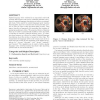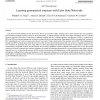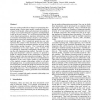1826 search results - page 120 / 366 » Using Random Forests in the Structured Language Model |
ECMDAFA
2008
Springer
14 years 11 months ago
2008
Springer
Abstract. Today's graphical modelling languages, despite using symbols and connections, represent large model parts as structured text. We benefit from sophistic text editors,...
ICMI
2009
Springer
15 years 4 months ago
2009
Springer
Spatial language video retrieval is an important real-world problem that forms a test bed for evaluating semantic structures for natural language descriptions of motion on natural...
NN
2007
Springer
14 years 9 months ago
2007
Springer
Echo State Networks (ESNs) have been shown to be effective for a number of tasks, including motor control, dynamic time series prediction, and memorizing musical sequences. Howeve...
LATA
2010
Springer
14 years 8 months ago
2010
Springer
We apply language theory to compare the expressive power of models that extend Petri nets with features like colored tokens and/or whole place operations. Specifically, we conside...
ACSC
2009
IEEE
15 years 4 months ago
2009
IEEE
Most text mining methods are based on representing documents using a vector space model, commonly known as a bag of word model, where each document is modeled as a linear vector r...



